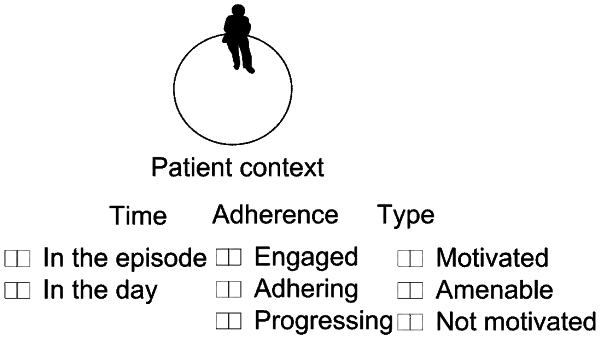| CPC A61B 5/486 (2013.01) [A61B 5/0002 (2013.01); A61B 5/01 (2013.01); A61B 5/1032 (2013.01); A61B 5/1114 (2013.01); A61B 5/1118 (2013.01); A61B 5/1121 (2013.01); A61B 5/165 (2013.01); A61B 5/224 (2013.01); A61B 5/4519 (2013.01); A61B 5/4528 (2013.01); A61B 5/4806 (2013.01); A61B 5/4824 (2013.01); A61B 5/4833 (2013.01); A61B 5/4884 (2013.01); A61B 5/6801 (2013.01); A61B 5/7275 (2013.01); A61B 5/742 (2013.01); A61B 5/746 (2013.01); G16H 20/30 (2018.01); G16H 40/67 (2018.01); A61B 2562/0219 (2013.01)] | 16 Claims |

|
1. A monitoring system for guiding a user through an adaptive care plan to improve engagement and adherence to the adaptive care plan,
the monitoring system comprising:
at least one sensor configured to be worn on or around a body portion of the user,
the at least one sensor positioned within a stretchable component via a holder of the stretchable component,
the holder being configured to maintain a fixed location of the at least one sensor upon the body portion,
and wherein the at least one sensor is configured to obtain a plurality of measurements that include positional and orientational assessments of the body portion taken over a period of time and measured from the fixed location of the at least one sensor on the body portion during performance of one or more exercises provided as part of an adaptive care plan;
a processor communicatively coupled to the at least one sensor,
the processor comprising instructions stored thereon,
wherein the instructions, when executed by the processor, cause the processor to:
receive the plurality of measurements;
extract a pattern from the plurality of measurements,
wherein the pattern comprises a range of motion of the body portion or a quality of performance of the one or more exercises;
determine a change in the range of motion or a change in the quality of performance of the body portion based on comparing the pattern to at least one baseline pattern associated with the user;
receive an input including a feature of a user personality type and one or more of: user symptoms and user pain level;
wherein the user personality type comprises an assessed psychological motivation level that falls into a plurality of categories,
wherein the categories are machine classified levels of motivation;
determine a recovery trajectory for the user based on the input and the determined changes in the range of motion or the changes in the quality of performance of the body portion;
generate an updated adaptive care plan based on the determined recovery trajectory;
and generate, based on the updated adaptive care plan, a visual user interface dashboard including personalized messages to the user that facilitate adherence to the updated adaptive care plan;
wherein the user personality type is used to generate at least a portion of the visual user interface dashboard.
|